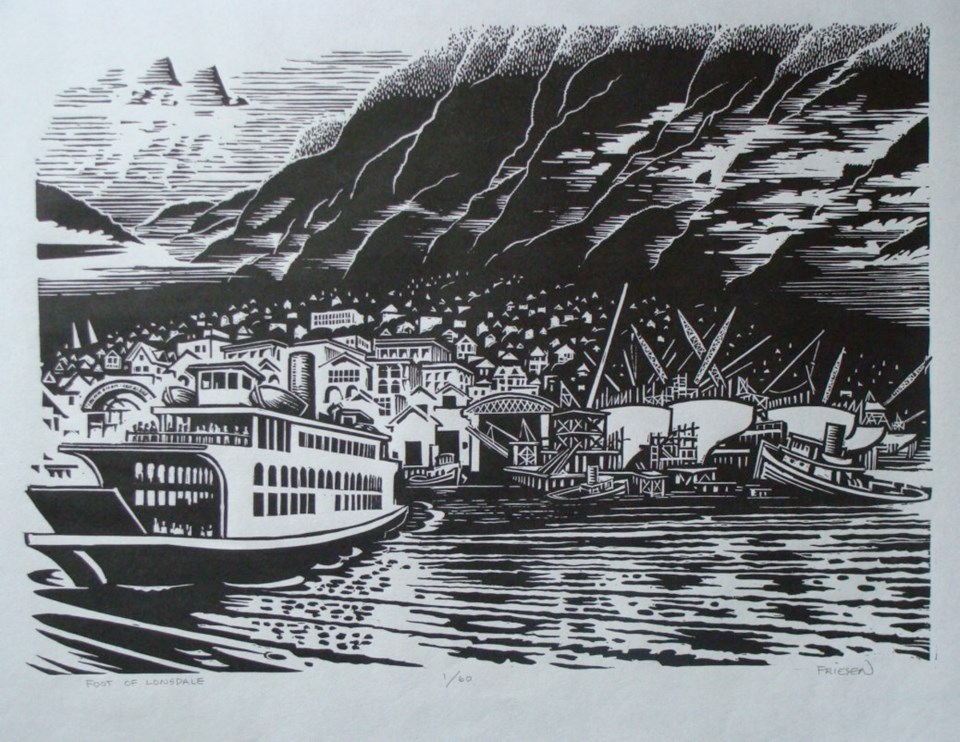The Art Gallery of Greater Victoria is hosting two exhibitions by outstanding printmakers. Black Ice is the definitive show of narrative etchings by David Blackwood showing his Newfoundland home (until Sept. 8), while a smaller show presents coloured woodcuts of Japanese landscapes made by the sublimely talented Hasui Kawase in the 1920s and ’30s (until July 14).
When I visit the gallery, I always make a point of sharing observations with Gordon Friesen, who works as the security guard there. Friesen is himself an excellent printmaker, making his prints with the very democratic medium of linoleum block cutting.
Along with fellow artist Sabina Proulx, herself a talented etcher, Friesen is presenting his recent work at the Martin Batchelor Gallery (712 Cormorant St., until June 27). In preparation, I visited him in his modest apartment where much of the space is given over to the cutting and storage of his blocks. He prints them not with a press but with a wooden spoon.
Modern linoleum is not thick enough for carving and usually has a plastic veneer surface. The linoleum sold in art-supply stores for art projects is too fine for Friesen. He likes to use old pieces of “battleship linoleum,” a thick material made of powdered cork bound up with an oil-based binder, and enjoys the slightly crumbly texture of the old material.
Back in his school days studying art in Nelson, Friesen began making prints by cutting his designs into blocks of wood, as many famous artists have done, but unlike wood, linoleum has no grain to contend with and allows free cutting in any direction.
The Victoria Art Gallery’s shows are always an inspiration to him while he’s on duty. We talked about the work of Albrecht Durer, who engraved rather than chiselled his printing blocks. German expressionists at the time of the First World War, like Erich Heckel, loved the roughness of woodcuts, and Frans Masereel created graphic novels using that medium. Working in Britain in the 1930s, Sybil Andrews made colour linocuts of stylized Vorticist images of motorcycles and the like, bringing her skills to Campbell River soon after.
Her prints of logging trucks have become some of Canada’s most sought-after prints. Friesen took this all in.
Narrative and slightly nostalgic, his work is in line with one of his heroes, the inimitable Robert Crumb, artist-laureate of the hippie era. In his new series, Friesen has created a number of figurative images — a psychologist concerned with the idea of time, a gypsy with his hat piled high with images of luck, and a man named Corker rolling marine oakum.
In telling me about Corker, Friesen led me into scenes from his childhood. Oakum is hemp fibre that is rolled onto spools, and later hammered into seams of a wooden ship’s hull to caulk it. A larger image is a memory piece, built up from archival photos and his childhood recollections of the shipyard his father worked in at the foot of Bidwell Street on Vancouver’s Coal Harbour. The tools Corker uses in the print are studied after Friesen’s father’s chisels. Friesen made a trip to North Vancouver to sketch the shore and mountains behind, foregrounding his Foot of Lonsdale with a ferry coming into the wharf.
There is a lovely sympathy between the Vancouver period pieces he illustrates and his medium: black and white in contrast and slightly cartoonish. Friesen has created a scene of beatniks heading down Hastings Street in front of the old Lux Theatre, and another of the view looking from 33rd and Fraser to the slopes of the North Shore.
Linocuts seem to suggest posters and cartoons and Friesen brings in a bit of political consciousness, showing The Force beating up a nondescript group of rioters. His stark evocations of our coastal islands bring to mind the radical simplification of Rockwell Kent and Lawren Harris, two artists of the 1930s who created streamlined views of landscape. A closer look at Friesen’s coastal images shows the clearcut blocks that have deforested the hillsides. Cut blocks, block cutting — it seems appropriate.
Friesen acknowledged the superb linocuts of his Victoria contemporary Nick Vandergugten and is already looking forward to a forthcoming AGGV show of Japanese master woodcut artist Kiyoshi Saito, who worked in the 1950s (June 21 to Nov. 3).
Whether world-famous or modest and local, each of these artists makes very small editions offered at affordable prices. If you would like to start an art collection, you could begin with some hand-made prints. Consider buying Friesen’s whole set, one sheet at a time. They are already part of our history.
Splendid Diversity: Sabina Proulx and Gordon Friesen at the Martin Batchelor Gallery (712 Cormorant St., 250-385-7919, until June 27). The work of each artist can be seen on their websites.



